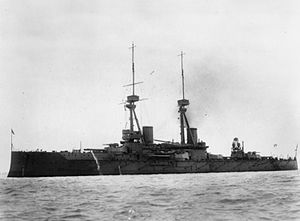 Superb at anchor, shortly after completion in 1909
| |
| History | |
|---|---|
| Name | Superb |
| Ordered | 26 December 1906 |
| Builder | Armstrong Whitworth, Elswick |
| Laid down | 6 February 1907 |
| Launched | 7 November 1907 |
| Commissioned | 29 May 1909 |
| Decommissioned | 26 March 1920 |
| Out of service | May 1922 |
| Fate | Sold for scrap, December 1922 |
| General characteristics (as built) | |
| Class and type | Bellerophon-class dreadnought battleship |
| Displacement | 18,596 long tons (18,894 t) (normal) |
| Length | 526 ft (160.3 m) (o/a) |
| Beam | 82 ft 6 in (25.1 m) |
| Draught | 27 ft (8.2 m) |
| Installed power |
|
| Propulsion | 4 × shafts; 2 × steam turbine sets |
| Speed | 21 knots (39 km/h; 24 mph) |
| Range | 5,720 nmi (10,590 km; 6,580 mi) at 10 knots (19 km/h; 12 mph) |
| Complement | 840 |
| Armament |
|
| Armour | |
HMS Superb was one of three Bellerophon-class dreadnought battleships built for the Royal Navy in the first decade of the 20th century. She spent almost her whole career assigned to the Home and Grand Fleets. Aside from participating in the Battle of Jutland in May 1916 and the inconclusive action of 19 August, her service during the First World War generally consisted of routine patrols and training in the North Sea.
Superb was transferred to the Mediterranean Fleet in October 1918 and became its flagship. She supported Allied forces in the Mediterranean and the Black Sea after the war ended in November. The ship was deemed obsolete and was reduced to reserve when she returned home in early 1919 and was then used as a training ship. Superb was used for gunnery experiments in 1920 and then became a target ship in 1922. The ship was sold for scrap late that year and broken up in 1923.